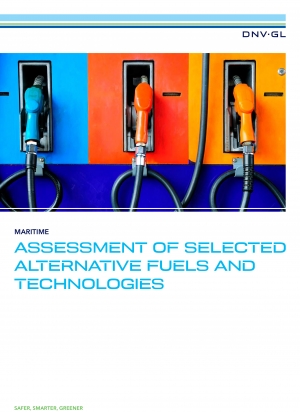


(Posted on 26/04/18)
Classification society DNV GL has issued a new white paper which assesses a range of alternative fuels and technologies. The white paper ‘Alternative fuels and technologies for greener shipping’ examines the price, availability, regulatory challenges and environmental benefits of alternative fuels and technologies, including LNG, LPG, hydrogen, fuel cells, and hybrid and battery technologies, and comparing them to the use of conventional fuel with scrubbers and new low sulphur alternatives. Through the new white paper DNV GL intends to offer the shipping industry insights that will help them in their preparations for the upcoming Global Sulphur Cap, which is due to come into effect on 1 January 2020.
“The incoming International Maritime Organization (IMO) sulphur cap on emissions from shipping could have a significant effect on the maritime industry, and it has the potential to be a game changer for alternative fuels,” says Trond Hodne, Senior Vice President, Sales & Marketing Director at DNV GL – Maritime. “Our new white paper is designed to set out the options for interested stakeholders and to offer a balanced assessment of the potential of these fuels and technologies going forward. We hope that by doing so we can add to the growing body of knowledge and enable investment decisions to be made with greater certainty and confidence.”
The technologies and fuels considered in the white paper are many of the most commonly used in the shipping industry today: LNG, LPG, methanol, biofuel, hydrogen, battery systems, fuel cell systems, and wind-assisted propulsion. The white paper identifies and examines the factors that will affect the uptake and acceptance of alternative fuels and technologies in shipping, including: environmental compatibility, availability, fuel costs and the international rules within the IGF Code. Over the short term, the white paper foresees that the vast majority of conventionally fuelled vessels already in service will either switch to low sulphur conventional fuels, or implement a scrubber system while continuing to use heavy fuel oil (HFO).
For newbuilding vessels, the sulphur cap could be a major driver for alternative fuels, and DNV GL’s Gerd Würsig, Business Director Alternative fuelled ships, at DNV GL – Maritime, believes that LNG is the prime contender among them: “LNG has already overcome the barriers related to international legislation and is available in sufficient quantities today to meet the requirements of the shipping industry for many years. It also fits within the trend of demands to lower emissions of CO2, NOx and particulate matter. At the end of the day however, the best concept for a given application needs to be determined by the shipowner on a case-by-case basis, and at DNV GL we are ready to assist in finding the best solution.”
Anemoi Marine Technologies, the UK-based leading designer of Rotor Sails for wind-assisted ship propulsion... Read more
Helm Operations has announced that nine electronic record books within Helm CONNECT Logbook have been... Read more
International maritime welfare charity Sailors’ Society has announced a significant expansion... Read more
NORDEN has signed a two-year Contract of Affreightment (COA) with Enviva to transport a significant... Read more
Algoma Central Corporation has reported its results for the three and nine months ended 30 September... Read more
Damen Shipyards Group has unveiled the latest platform in its successful cargo vessels portfolio. The... Read more
Wallem Group, a leading global maritime partner, is celebrating the centenary of moving its headquarters... Read more
The International Association of Dry Cargo Shipowners (INTERCARGO) is marking its 45th anniversary in... Read more
Net profit for the Group amounted to USD 26 million (DKK 166 million) in the third quarter of 2025,... Read more
ClassNK has released 'Guidelines for Onboard CO2 Capture and Storage Systems (Edition 2.0)' first in... Read more